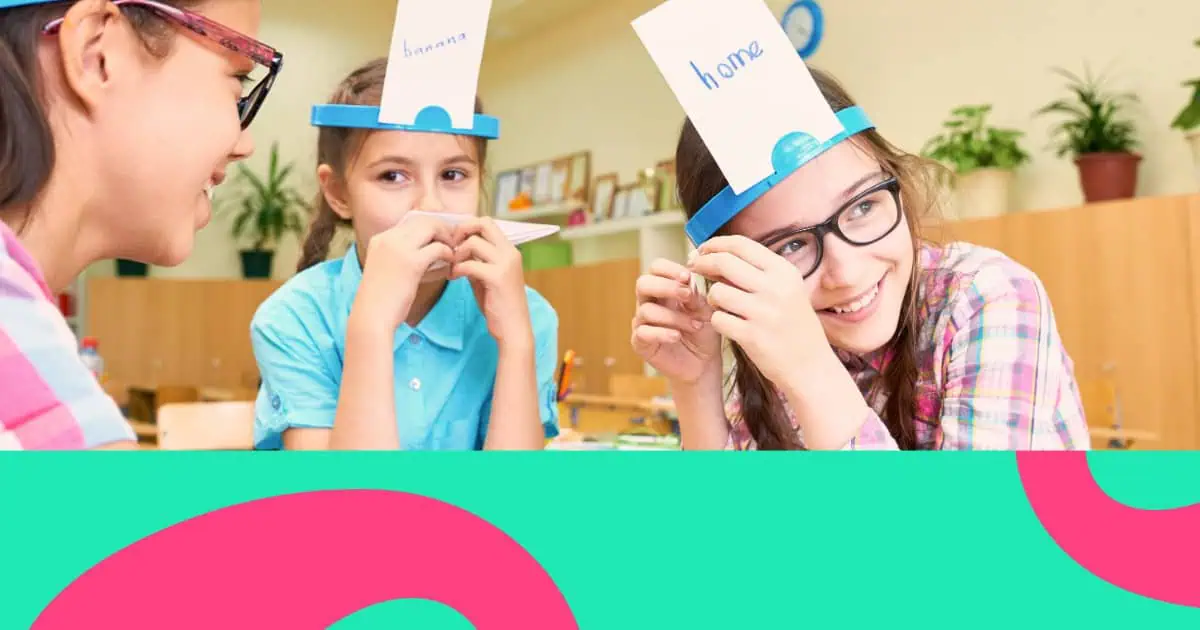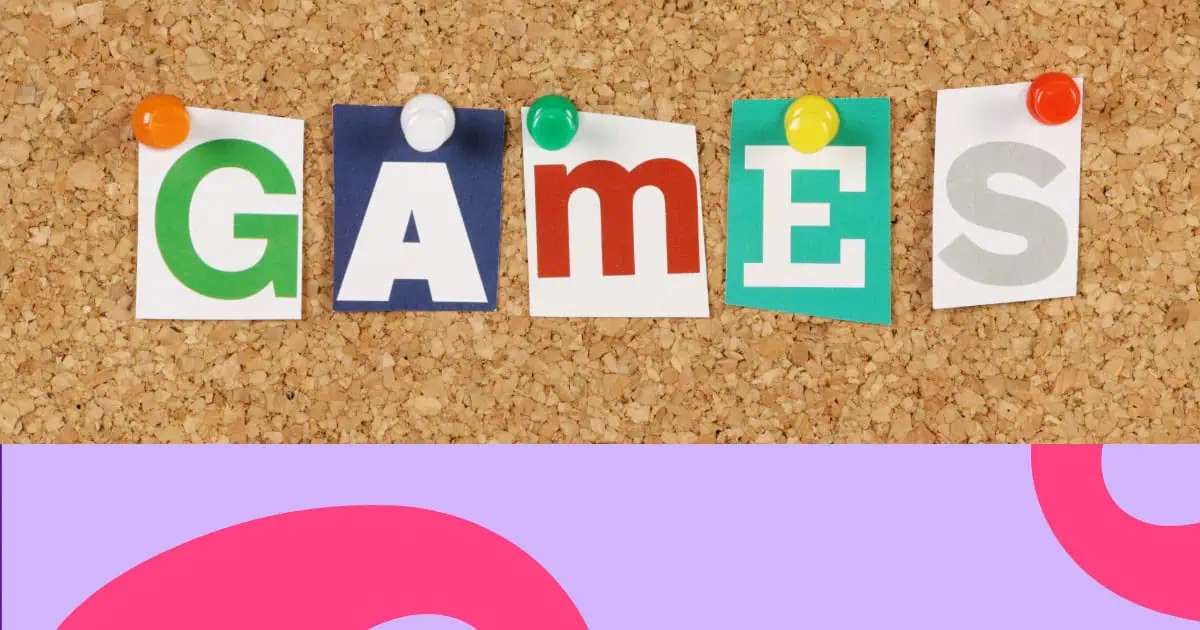Sia chì avete amparatu da a casa o solu per vultà in u groove di aula, ricunniscendu Face-to-Face pò esse scunfittu prima.
Per furtuna, avemu 20 super divertenti ghjochi icebreaker per i studienti è attività facili senza preparazione per rilassà è rinfurzà di novu quelli ligami d'amicizia.
Quale sà, i studienti puderanu ancu scopre un novu BFF o dui in u prucessu. È ùn hè micca cusì chì a scola hè tutta - fà ricordi, scherzi in l'internu è amicizia durabile per guardà in daretu ?
Per rinfurzà l'ingaghjamentu di i studienti è custruisce u so interessu in l'apprendimentu, hè essenziale mischjà e classi cù attività divertenti per i studienti. Scuprite alcuni di questi gruppi eccitanti:
Rompighiacciu di scola elementaria (età 5-10)
🟢 Livellu principiante (età 5-10)
1. Induvina e imagine
Objettiv: Sviluppà cumpetenze d'osservazione è vucabulariu
Cumu ghjucò:
- Selezziunate imagine relative à u tema di a vostra lezione
- Zoom in è ritagliateli in modu creativo
- Mustrà una maghjina à a volta
- I studienti indovinanu ciò chì mostra l'imagine
- A prima supposizione curretta vince un puntu
Integrazione di AhaSlides: Crea diapositive di quiz interattivi cù immagini, chì permettenu à i studienti di mandà risposte via i so dispositivi. I risultati in tempu reale si mostranu nantu à u schermu.
💡 punta Pro: Aduprate a funzione di rivelazione di l'imagine di AhaSlides per mustrà gradualmente più di l'imagine, custruendu suspense è ingaghjamentu.
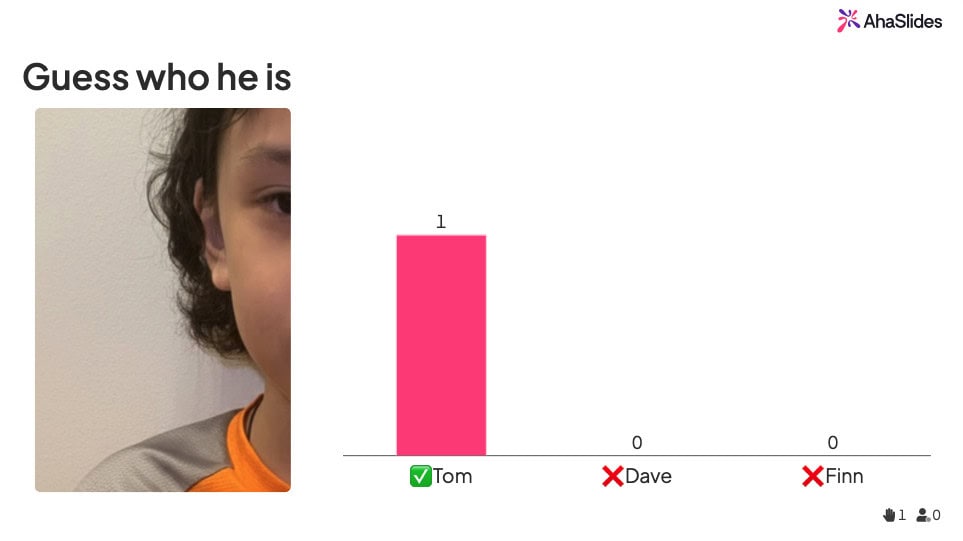
2. Sciarade di emoji
Objettiv: Migliurà a creatività è a cumunicazione non verbale
Cumu ghjucò:
- Ghjucate in squadre per una cumpetizione supplementare
- Crea una lista di emoji cù significati diversi
- Un studiente sceglie un emoji è u mette in scena
- I cumpagni di classe indovinanu l'emoji
- A prima supposizione curretta guadagna punti
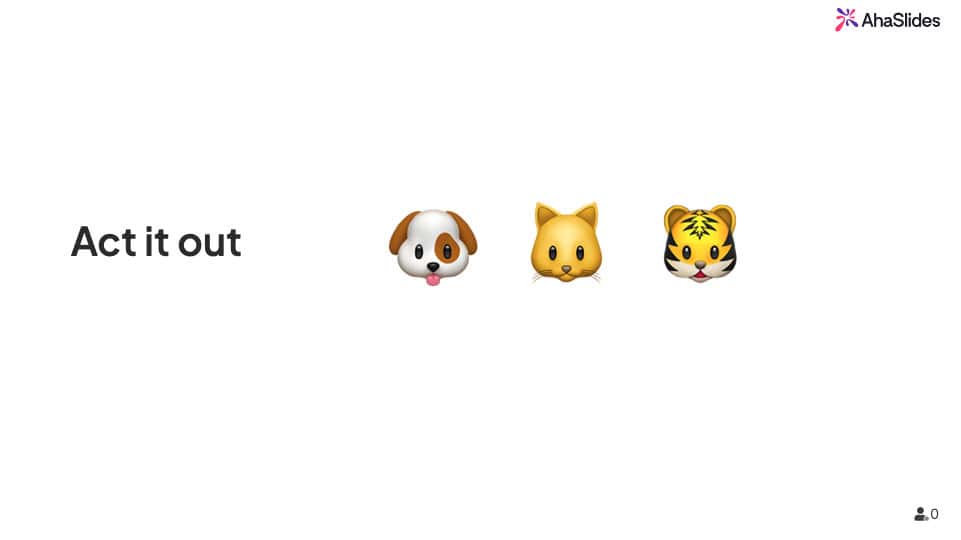
3. Simone dice
Objettiv: Migliurà e cumpetenze d'ascolta è di seguità l'istruzzioni
Cumu ghjucò:
- U maestru hè u capu (Simon)
- I studienti seguitanu i cumandamenti solu quandu sò prefissi cù "Simon dice".
- I studienti chì seguitanu i cumandamenti senza "Simon dice" sò fora.
- L'ultimu studiente in piedi vince
🟡 Livellu intermediu (8-10 anni)
4. 20 dumande
Objettiv: Sviluppà u pensamentu criticu è e cumpetenze di dumanda
Cumu ghjucò:
- Divide a classa in squadre
- U capu di squadra pensa à una persona, un locu o una cosa
- A squadra riceve 20 dumande sì/nò da indovinà
- Induvina curretta in 20 dumande = a squadra vince
- Altrimenti, u capu vince
5. Pizianu
Objettiv: Migliurà a creatività è a cumunicazione visuale
Cumu ghjucò:
- Aduprate una piattaforma di disegnu in linea cum'è Drawasaurus
- Creà una stanza privata per un massimu di 16 studienti
- Un studiente disegna, l'altri indovinanu
- Trè chance per sorteggio
- A squadra cù u più grande numeru di risposte currette vince
6. Eiu spiu
Objettiv: Migliurà e cumpetenze d'osservazione è l'attenzione à i dettagli
Cumu ghjucò:
- I studienti descrivenu l'uggetti à turnu
- Aduprate aggettivi: "Aghju vistu qualcosa di rossu nantu à a tavula di u maestru"
- U prossimu studiente indovina l'ughjettu
- L'indovina curretta diventa a prossima spia
Rompighiacciu di scola media (età 11-14)
🟡 Livellu intermediu (11-12 anni)
7. Top 5
Objettiv: Incuragisce a participazione è scopre interessi cumuni
Cumu ghjucò:
- Date à i studienti un tema (per esempiu, "i 5 migliori spuntini per a pausa")
- I studienti elencanu e so scelte nantu à una nuvola di parolle in diretta
- L'entrate più pupulari parenu più grande
- I studienti chì anu indovinatu #1 ottenenu 5 punti
- I punti diminuiscenu cù a classificazione di pupularità
💡 punta Pro: Aduprate a funzione di nuvola di parolle per creà visualizazioni in tempu reale di e risposte di i studienti, cù a dimensione chì indica a pupularità. L'aghjurnamenti di a nuvola di parolle di AhaSlides sò fatti in tempu reale, creendu una rapprisentazione visuale attraente di e preferenze di classe.
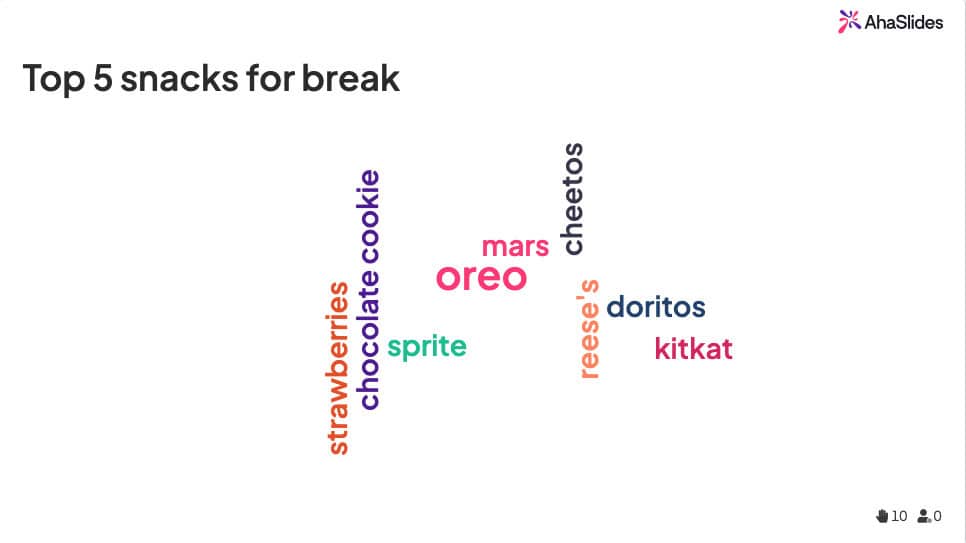
8. Quiz di a bandiera di u mondu
Objettiv: Custruisce a cuscenza culturale è a cunniscenza geografica
Cumu ghjucò:
- Divide a classa in squadre
- Mostra bandiere di diversi paesi
- E squadre nominanu i paesi
- Trè dumande per squadra
- A squadra cù u più grande numeru di risposte currette vince
Integrazione di AhaSlides: aduprà u funzione di quiz per creà ghjochi interattivi d'identificazione di bandiere cù opzioni à scelta multipla.
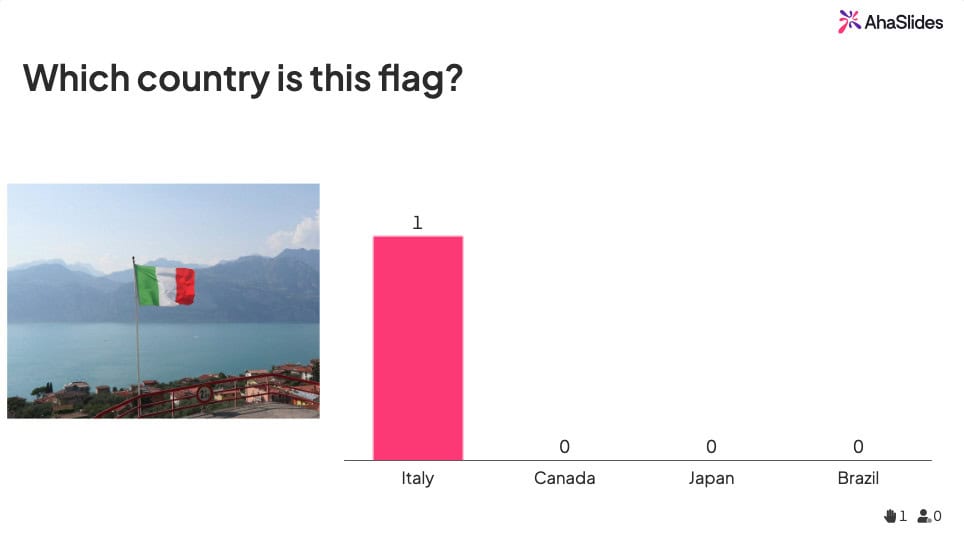
9. Induvina u sonu
Objettiv: Sviluppà e cumpetenze auditive è a cuscenza culturale
Cumu ghjucò:
- Sceglite un tema d'interessu (cartoni animati, canzoni, natura)
- Riproduce clip audio
- I studienti indovinanu ciò chì u sonu rapprisenta
- Registrate e risposte per a discussione
- Discutite u ragiunamentu daretu à e risposte
🟠 Livellu avanzatu (13-14 anni)
10. Curiosità di u weekend
Objettiv: Custruisce una cumunità è sparte esperienze
Cumu ghjucò:
- Weekend Trivia hè perfettu per batte u blues di u luni è un grande icebreaker in aula per i liceani per sapè ciò chì anu fattu. Utilizà un strumentu di presentazione interattivu gratuitu cum'è AhaSlides, pudete urganizà una sessione aperta induve i studienti ponu risponde à a dumanda senza limite di parolle.
- Allora dumandate à i studienti di indovinà quale hà fattu ciò chì u weekend.
- Dumandate à i studienti ciò chì anu fattu u weekend.
- Pudete stabilisce un limitu di tempu è vede e risposte una volta chì tutti anu sottumessu u so.
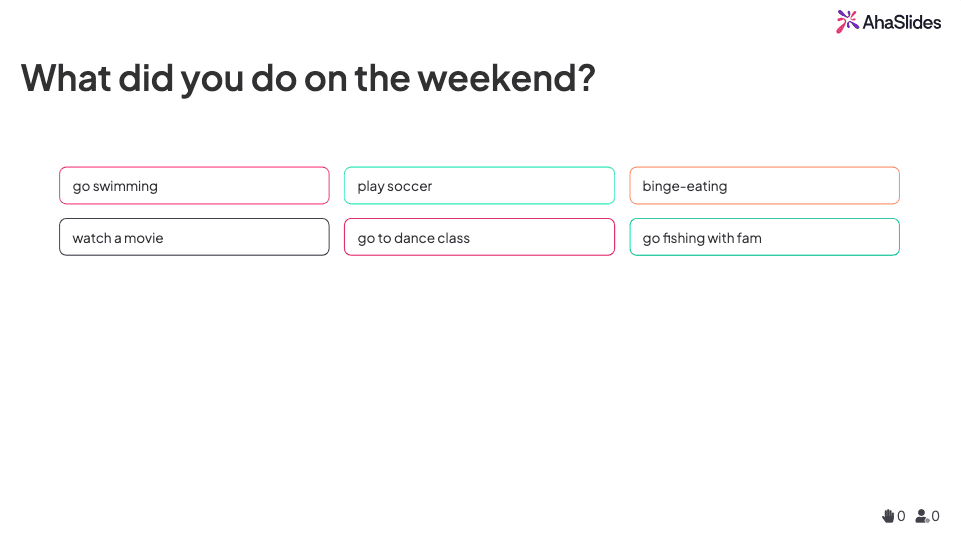
11. Piramide
Objettiv: Sviluppà u vucabulariu è u pensamentu assuciativu
Cumu ghjucò:
- Discute i ligami è e relazioni
- Affissà una parolla aleatoria (per esempiu, "museu")
- E squadre facenu un brainstorming di 6 parolle correlate
- E parolle devenu esse culligate à a parolla principale
- A squadra cù u più grande numeru di parolle vince
12. Maffia
Objettiv: Sviluppà u pensamentu criticu è e cumpetenze suciali
Cumu ghjucò:
- Assignà roli secreti (mafia, detective, citatinu)
- Ghjucate in round cù fasi di ghjornu è di notte
- A mafia elimina i ghjucatori di notte
- I citadini votanu per eliminà i suspettati durante u ghjornu
- A mafia vince s'ella hè più numerosa di i citadini
Rompighiacciu di u liceu (età 15-18)
🔴 Livellu avanzatu (15-18 anni)
13. Unu fora di l'ordinariu
Objettiv: Sviluppà u pensamentu analiticu è e cumpetenze di ragiunamentu
Cumu ghjucò:
- Prisentanu gruppi di 4-5 elementi
- I studienti identificanu quellu chì hè stranu
- Spiegate u ragiunamentu daretu à a scelta
- Discutite diverse perspettive
- Incuraghjenu u pensamentu creativo
14. Memoria
Objettiv: Migliurà e cumpetenze di memoria è l'attenzione à i dettagli
Cumu ghjucò:
- Mostra l'imagine cù parechji oggetti
- Date 20-60 seconde per memorizà
- Eliminà l'imagine
- I studienti elencanu l'uggetti chì si ricordanu
- A lista più precisa vince
Integrazione di AhaSlides: Aduprate a funzione di rivelazione di l'imagine per mustrà l'uggetti, è a nuvola di parolle per raccoglie tutti l'articuli ricordati.
15. Inventariu d'interessi
Objettiv: Custruisce relazioni è scopre interessi cumuni
Cumu ghjucò:
- I studienti cumpletanu a scheda di travagliu d'interessu
- Includite passatempi, filmi, lochi, cose
- L'insegnante mostra una scheda di travagliu per ghjornu
- A classa indovina à quale appartene
- Rivelate è discute interessi cumuni
16. Colpiscelu in cinque
Objettiv: Sviluppà un pensamentu rapidu è a cunniscenza di e categurie
Cumu ghjucò:
- Sceglite a categuria (insetti, frutti, paesi)
- I studienti nominanu 3 elementi in 5 secondi
- Ghjucà individualmente o in gruppi
- Seguite e risposte currette
- A maiò parte di e vittorie currette
17. Piramide
Objettiv: Sviluppà u vucabulariu è u pensamentu assuciativu
Cumu ghjucò:
- Affissà una parolla aleatoria (per esempiu, "museu")
- E squadre facenu un brainstorming di 6 parolle correlate
- E parolle devenu esse culligate à a parolla principale
- A squadra cù u più grande numeru di parolle vince
- Discute i ligami è e relazioni
18. Anch'eiu
Objettiv: Custruisce cunnessione è scopre punti cumuni
Cumu ghjucò:
- U studiente sparte una dichjarazione persunale
- Altri chì si identificanu dicenu "Anch'eiu"
- Furmà gruppi basati annantu à interessi cumuni
- Cuntinuà cù diverse dichjarazioni
- Aduprà i gruppi per attività future
Integrazione di AhaSlides: Aduprate a funzione di nuvola di parolle per raccoglie risposte "Me too", è a funzione di raggruppamentu per urganizà i studienti per interessi.
Rompighiacciu di l'apprendimentu virtuale
💻 Attività rinfurzate da a tecnulugia
19. Caccia à u tesoru virtuale
Objettiv: Implicà i studienti in un ambiente virtuale
Cumu ghjucò:
- Crea una lista di l'articuli da truvà in casa
- I studienti cercanu è mostranu oggetti in camera
- U primu à truvà tutti l'uggetti vince
- Incuragisce a creatività è l'ingegnosità
- Discutite i risultati è l'esperienze
20. Registrazione in una sola parola
Objettiv: Adupratu prima è dopu a classa per valutà i sentimenti è cum'è un rompe-ghiacciu.
Cumu ghjucò:
- I studienti creanu sfondi virtuali persunalizati
- Sparte i sfondi cù a classa
- Vutate per u disignu u più creativo
- Aduprate sfondi per e sessioni future
Integrazione di AhaSlides: Aduprate a funzione d'imagine per vede i disinni di fondu, è a funzione di votu per selezziunà i vincitori.
Cunsiglii d'esperti per un impegnu massimu
🧠 Strategie d'ingaghjamentu basate nantu à a psiculugia
- Cumincià cù attività à pocu risicu: Cuminciate cù ghjochi simplici è micca minacciosi per custruisce a fiducia
- Aduprà rinforzu pusitivu: Celebremu a participazione, micca solu e risposte currette
- Creà spazii sicuri: Assicuratevi chì tutti i studienti si sentinu à l'aise à participà
- Varià u furmatu: Mischiate attività individuali, in coppia è in gruppu
🎯 Sfide è suluzioni cumuni
- Studenti timidi: Aduprate u votu anonimu o attività in picculi gruppi
- Grandi classi: Dividetevi in gruppi più chjuchi o aduprate strumenti tecnologichi
- custrizzione Time: Sceglite attività veloci di 5 minuti
- Impostazioni virtuali: Aduprate piattaforme interattive cum'è AhaSlides per l'ingaghjamentu
📚 Benefici sustinuti da a ricerca
Quandu sò implementati currettamente, i rompighiacciu per i studienti ponu avè numerosi benefici secondu a ricerca:
- Participazione aumentata
- Ansietà ridutta
- Rilazioni megliu
- Apprendimentu rinfurzatu
(Source: Educazione medica)
Chiave Takeaways
I ghjochi Icebreaker per i studienti vanu al di là di rompe u ghjacciu iniziale è invitanu a conversazione, prumove una cultura di sulidarità è apertura trà i prufessori è i studienti. L'integrazione frequente di ghjochi interattivi in aula hè dimustrata per avè parechji benefizii, dunque ùn ti scurdate micca di divertevi!
Circà parechje piattaforme per ghjucà à ghjochi è attività senza preparazione pò esse scoraggiante, soprattuttu quandu avete tunnellate da preparà per a classa. AhaSlides offre una vasta gamma di opzioni di presentazione interattive chì sò divertenti per i prufessori è i studienti.
Dumande dumandatu Spissu
Cumu adattà i rompighiaccio per diverse fasce d'età?
Per i studienti più ghjovani (5-7 anni), cuncentratevi nantu à attività simplici è visuali cù struzzioni chjare. Per i studienti di u liceu (11-14 anni), incorporate elementi tecnologichi è suciali. I studienti di u liceu (15-18 anni) ponu trattà attività più cumplesse è analitiche chì incuraghjenu u pensamentu criticu.
Chì sò 3 divertenti dumande di icebreaker?
Eccu 3 divertenti dumande di icebreaker è ghjochi chì i studienti ponu aduprà:
1. Dui verità è una bugia
In questu classicu, i studienti si turnanu dicendu 2 dichjarazioni veri nantu à elli stessi è 1 minzogna. L'altri anu da indovinà quale hè a minzogna. Questu hè un modu divertente per i cumpagni di classe per amparà fatti veri è falsi nantu à l'altri.
2. Preferite...
Fate chì i studienti s'accoppianu è facenu turnate dumande "preferite" cù un scenariu stupidu o una scelta. Esempii ponu esse: "Preferite solu beie soda o sucu per un annu?" Questa quistione ligera permette à e persone di brillà.
3. Chì ci hè in un nome ?
Fate un giru è fate dì à ogni persona u so nome, cù u significatu o l'origine di u so nome s'ellu u cunnosce. Questa hè una introduzione più interessante chè solu dì un nome, è face chì a ghjente pensi à e storie daretu à i so nomi. E variazioni puderanu esse u nome preferitu ch'elli anu mai intesu o u nome u più imbarazzante ch'elli possinu imaginà.
Chì ghjè una bona attività di introduzione?
U ghjocu di nomi hè una grande attività per i studienti per presentà si. Andanu in giru è dicenu u so nome cù un aggettivu chì principia cù a stessa lettera. Per esempiu "Jazzy John" o "Happy Hanna". Questu hè un modu divertente per amparà i nomi.
